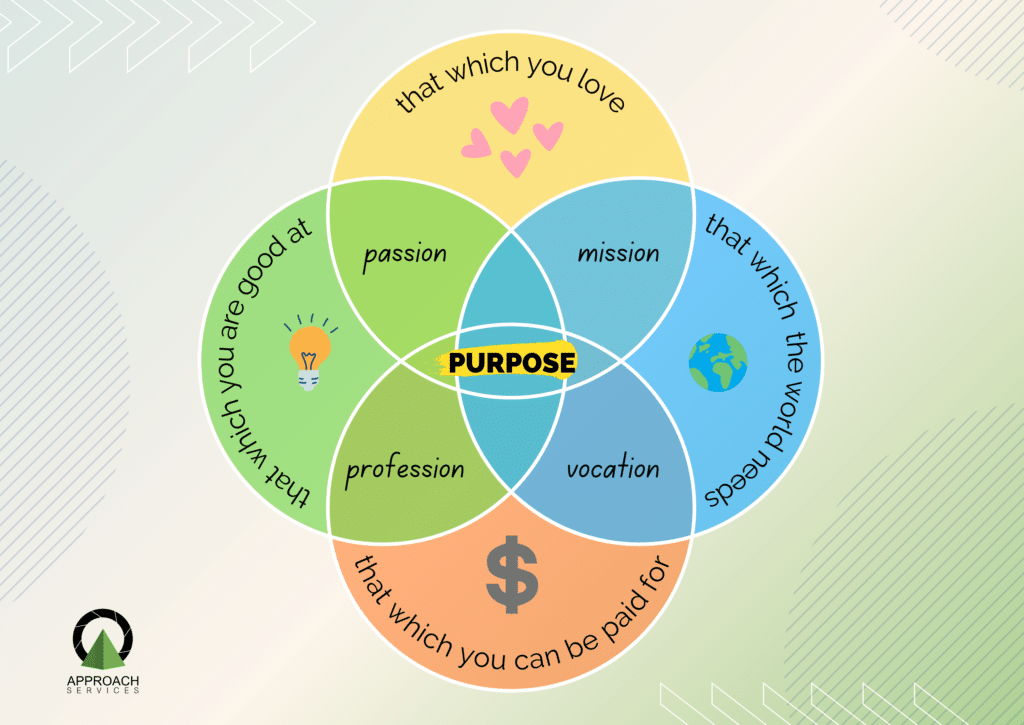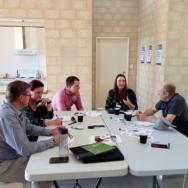What is your purpose?
This article has been inspired by a conversation about the Great Resignation with my dear friend and fellow entrepreneur, V.
In mindful May, we turn our attention inwards and take the opportunity to reflect on the meaning of life/work, aka our reason to get out of bed every morning.
You might use the Zuzunaga Venn Diagram of Purpose or Westernised version of Ikigai to hone into that sweet spot between what you love, you are good at, you can get paid for and what the world needs.

If your purpose isn't what you are doing today, you'll be bound to embark on a meaningful, transformational journey. No one likes to waste their time and energy with meaningless work for work's sake. And, there is a big payoff for this risky endeavour. Purposeful actions and connections boost our self-worth, growth, resilience, productivity and mental health.
More from our Blog
How to create measurable value with purposeful actions
Now that you know your destination, I bet you are ready for take-off!
But wait! Have you done your preflight checks? I don't want you to crash when it could have been avoided. Don't fly by the seat of your pants as the goalposts keep changing.
Eisenhower rightly said, "Plans are nothing; planning is everything."
Planning means thinking through all future possibilities and strategising how to tackle them. The Plan? Let's face it; things rarely go exactly to plan.
The Rapid Change Planning (RCP) process allows me to connect results to purpose and purpose to actions. Good thing! We have developed an RCP template along with some other change management templates to boost your change leadership.
Visualise your ascent, the flight, the obstacles, your strategies to overcome resistance and the smooth landing (and all the clapping from the happy passengers).
Clap, clap, clap... Are you unsure how to measure the ROI of your efforts? Dive deeper into Value Blueprinting with the Valēre Culture Board activity. Use the value cards to reflect on your behavioural compass, purpose and change championing culture.
I like to think through the following 10 checks, so I don't end up with lots of busy work and no ROI.
10 steps to create meaningful change
Step 1: Your purpose needs to be bulletproof
Did you know? 9 out of 10 employees are willing to trade a percentage of their lifetime earnings for greater meaning at work. So, getting this step right is critical. Let's be very clear on the compelling reason, aka the WHY, for the transformation. Test the narrative from more than one angle. Don't land on a superficial WHY, but dig deep.
Step 2: Align and integrate your transformation with the overall mission
Tie any change efforts back to the overall strategy, vision and values. The more you align and integrate the transformation with BAU, the more likely new habits will last past the project go-live. No one needs yet another flavour of the month transition project.
Step 3: Set a s.m.a.r.t. goal
If it isn't specific, measurable, achievable, realistic, and time-bound (s.m.a.r.t.), then it's called a dream. Your vision needs to be a description of the future state. Make it as tangible as possible for your audience by using vision boards and letting personas share their future experience.
Step 4: Communicate the changes
Open and effective communication acknowledges that successful business transformation needs individuals to successfully transition to the new way of working. Transparency signals choice and invites co-creation, feedback and engagement.
Step 5: Be accountable. Hold accountable.
Reflect on the choices and their consequences. Then take charge and act. Hold others accountable to act too. Did you know? Neuroscience research shows that during organisational change, employees value choices. Powerlessness impacts our well-being, motivation, and even problem-solving abilities.
Step 6: Connect
A sense of belonging creates a positive mindset and mental well-being. Purposeful connections improve our collaboration, agility and adaptability.
Your stakeholders become your change advocates and champions. You don't need to change the world alone.
Step 7: Establish a growth mindset culture
Company cultures are contagious. A growth mindset and active learning culture accelerate innovation and success. Did you know? CEOs rate the benefits of investing in development programs twice as high on culture and employee engagement than on closing a specific skill gap.
Step 8: Manage expectations
Behavioural change is tough. It helps understand the 4F Model and what change does with our brains and bodies. Be mindful and empathic during the transition. Expect some setbacks and obstacles along the way.
Step 9: Develop transferable skills
Leading change is rated the number one leadership skill needed in 2030. Did you know? Upskilling staff doubled the confidence in CEOs, revenue growth and the organisation's future. People are ready to reskill entirely to improve their future employability. Yet only 1:3 of employees are given that opportunity by their employer. Start simple with a dedicated training hour per week.
Step 10: Embrace resistance
Similar to visualising your goal, you should visualise obstacles and how you overcome them. Virtual resistance training has proven to train your muscles as much as physical exercise. Resistance to change is a given. Did you know? Embracing resistance as engagement can make your transformation's success 24% more likely.
That said. Thank you for your attention. Have a great flight!

Eva is one of the masterminds behind Approach Services' blog and The 6 Cents of Change. She is an innovator, trainer and change manager. Her work has been published in the Schmalenbach Journal of Business Research. In her spare time, she enjoys camping with her two little boys and permaculture gardening.
Subscribe to our monthly newsletter The 6 Cents of Change and follow us on LinkedIn to learn more!








